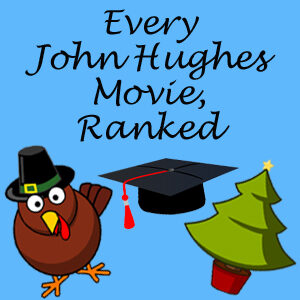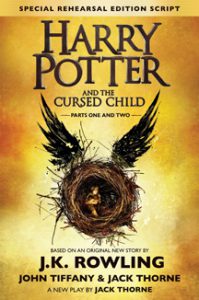For the 20th anniversary of “Harry Potter,” I’m looking back at the books and films of J.K. Rowling’s Wizarding World saga.
2007’s “Deathly Hallows” remains the most recent novel J.K. Rowling has penned in the Wizarding World, but she has expanded the saga since with Pottermore.com writings, the “Fantastic Beasts and Where to Find Them” screenplay and the stage play “Harry Potter and the Cursed Child”(2016). The latter represents the most generous she has been in opening her sandbox for others to play in: Jack Thorne wrote the script based on a story by Rowling, Thorne himself and John Tiffany, who directed the U.K. premiere of the play (which will debut on Broadway in September).
The unusually negative reviews (by “Potter” standards) of the play script kept me from reading it until its recent paperback release, which enticed me with a 20-percent-off sticker and bonuses of a Potter family tree and a timeline. After reading it, I concur with Rowling’s dedication to Thorne, whom she says “entered my world and did beautiful things there.” At the same time, I acknowledge that it’s missing something compared to the original seven novels – namely, the fact that it’s not a novel. Interestingly, the U.K. productions themselves have gotten glowing reviews and loads of awards, which seems to drive home the point that reading a play is not the same as seeing it.
This review, of course, can only be of the script.
I had mixed feelings about the epilogue of “Deathly Hallows” (which is repurposed as the first two scenes of “Cursed Child”). It jumps ahead 19 years to show Harry and Ginny and Ron and Hermione seeing their kids off to Hogwarts. I didn’t hate it, but it was arguably a heavy-handed “happily ever after.”
But in light of Rowling’s statement that she wrote that epilogue in 1990, when she first started “Sorcerer’s Stone,” I wonder if Harry’s adult life and perhaps a lot of “Cursed Child’s” plot points were in Rowling’s mind from the beginning. For the “Potter” novels, she was, after all, an adult writing about children and drawing from her own schooling experience. And given that the seven “Potter” books were set in the past (1991-98) relative to when she wrote them (1997-2007), maybe she saw those works as reflective from the point of view of the future.
To put it another way, maybe the purpose of the “Hallows” epilogue was to give us time to think about Harry’s adult life, and therefore be ready for “Cursed Child.”
Regardless of whether the whole “Potter” saga is reflective, “Cursed Child” certainly is. The plot finds Albus Potter (Harry and Ginny’s middle child) and Scorpius Malfoy (Draco’s child) using a Time-Turner in 2017 to travel to events from 1994-95 (the Tri-Wizard Tournament of “Goblet of Fire”) and, ultimately, 1981, when Voldemort murders Harry’s parents and baby Harry is fetched by Hagrid.
Once we’re caught up with the current state of the Wizarding World (generally peaceful since the Battle of Hogwarts), Rowling and Thorne serve up alternate realities. Similar to the “Buffy” Season 3 episode “The Wish,” we see a hellish future where Voldemort rules and Ron and Hermione are not married. Cleverly, this springs from the butterfly effect of Ron and Hermione attending the Yule Ball together, thus meaning that Ron never becomes jealous and engages in a romantic pursuit.

In the real future, Hermione is the Minister for Magic (why they changed it from “Minister of Magic” is not explained), Ron runs a Weasley’s Wizarding Wheezes franchise, Harry also works at the Ministry (I feel like I’ve heard he is an Auror, but that’s not strictly stated here), and Ginny seems to be a stay-at-home mom. Naturally, Neville is a Herbology professor.
Draco has a contentious truce with our heroes, but after the common travails of their sons going missing, he forges a friendship with Harry. Among major players in the original books, Ginny and Draco are the most underdeveloped, so it’s nice to see that rectified for Draco at least.
The kids from the novels have several children – the Potters have James, Albus and Lily; the Granger-Weasleys have Rose and Hugo; and Draco and his late wife produced Scorpius. However, “Cursed Child” focuses on Albus and Scorpius. The latter has a crush on Rose, and the popular James stands as a foil for the awkward Albus, but generally the other children need not exist. It gives me hope that Rowling has more stories planned about this generation (although she has said this marks the end of Harry’s story).
“Cursed Child” covers Albus’ and Scorpius’ first few years at Hogwarts. Albus is sorted into Slytherin, largely because he wants to be united with Scorpius, his only friend. Through these friends, Rowling rectifies a problem with the books: Although we’re sometimes told that there are decent people in Slytherin, there are no overt examples. (Slughorn is not evil, but he’s not heroic either, and we learn about Snape being on the side of good after he dies. And that doesn’t mean Snape was a good person; his treatment of Harry remains inexcusable.) It has also caused a problem for some readers, who can’t figure out how two kids of such decent moral fiber are in Slytherin, which can be traced back to the original problem.
One of the biggest talking points of “Cursed Child” is Harry’s flawed behavior, which even “Potter” superfan and Luna Lovegood actress Evanna Lynch criticized in a recent episode of Mugglecast. There’s sometimes a fine line between mischaracterization and a character behaving badly, and in my opinion (and in my apologia), Harry falls into the latter category.
The seven books comprise a coming-of-age saga, and Harry is the hero at the end, but “hero” is not synonymous with “person who has figured it all out.” Even “wise mentor” is not the same as “person who has figured it all out”; Dumbledore, who apologizes to Harry in “Deathly Hallows” for his missteps, is proof of this.
In “Cursed Child,” Rowling and Thorne examine the human nature of forgetting the feeling of what it was like to be a teenager, and of parenting your own troubled teenager without a guidebook. Rowling’s grasp of people age 11-17 is what made the “Potter” books great; in “Cursed Child,” she and Thorne perhaps purposely lose that grasp for the sake of Harry’s arc. This is bittersweet, but the alternative – Harry having all the answers – would be too convenient.
It’s no accident that “Cursed Child” features time travel, because Harry needs to be reminded of what it was like to be a kid, and Albus needs to be reminded that his dad was a kid once (and, significantly, one who didn’t have parents to raise him). Harry attempting to give Albus his most cherished possession – the blanket his mother wrapped him in – symbolizes the connection between cursed child and the cursed former child.
I’m certainly disappointed with Harry for ordering Albus to not see his only friend – and to fail to consult with Ginny – but you have to admit that Harry has always needed to be reminded that he doesn’t have to go it alone. Harry’s bad parenting decision is partially influenced by rumors that Scorpius is the son of Voldemort, which suggests that defeating Voldemort is not the same as defeating his fears of Voldemort. If someone survives a life-or-death situation, they might still be haunted by it, even though the danger is gone. As his children enter the age at which he fought Voldemort, he’s terrified of the idea of the Dark Lord’s resurrection, more so than when he was that age.
In the play’s big twist, another character – Delphi – is revealed to be the offspring of the Dark Lord (or at least she thinks she is). I’m surprised, in this day and age, that the “Potter” saga hasn’t been criticized for a shortage of well-developed female characters, especially with males being the leads of both “Cursed Child” and “Fantastic Beasts.” Perhaps Rowling is given a pass because she herself is a woman, or perhaps Hermione is such a strong figure that she overshadows the imbalance and the fact that Ginny is always underused. This is particularly sad here, as Ginny really should step up and share parenting duties rather than merely scolding Harry.
Rose Granger-Weasley – who scorns Scorpius and could use a lesson from her folks about prejudging people (this might’ve been a good role for the underused Ron to play) – is also pushed to the side, but Rowling and Thorne somewhat make up for it with villain-of-the-piece Delphi. She claims to be the niece of Amos Diggory, who believes Harry owes it to him to use a Time-Turner to save Cedric. (For all his faults, Harry knows not to mess with time travel, so he declines.) When Delphi finally has to resort to using magic against her hookwinked helpers Albus and Scorpius, she says: “I thought I’d have to use plenty more (spells). But you’re far easier to control than Amos – children, particularly male children, are so naturally pliant, aren’t they?”
Maybe I’m somewhat pliant for defending “Cursed Child,” but I wonder if some of the negative reviews come from the fact that this is a stage play. By its very nature, it lacks Rowling’s delicious prose. In this medium, the dialogue has no adverbs or surrounding humor to prop it up, and it can feel comparatively flat. The script’s other words are stage directions, not scene-setters like you would find in a movie script. And I don’t doubt that many scenes are written in a simple fashion BECAUSE this is a play, and it can’t do everything a book or movie can do.
The “Potter” novels are credited with sparking kids’ imaginations, but it’s Rowling herself who has the wonderful imagination. If you haven’t seen the play yet (which is the case for most of us), “Cursed Child” requires imagination from a reader to fill in the details. Of course, I would rather this eighth story had started as a Rowling novel and then been adapted for the stage. I doubt there are many fans who fully embrace the author’s assertion that “when audiences see the play they will agree that it is the only proper medium for the story.”
But for whatever reason, she chose this medium, and I think “Cursed Child” is a respectable continuation of the saga and fine first step onto the stage, even if – in script form – it doesn’t hold a lumos charm to the seven “Potter” novels.

